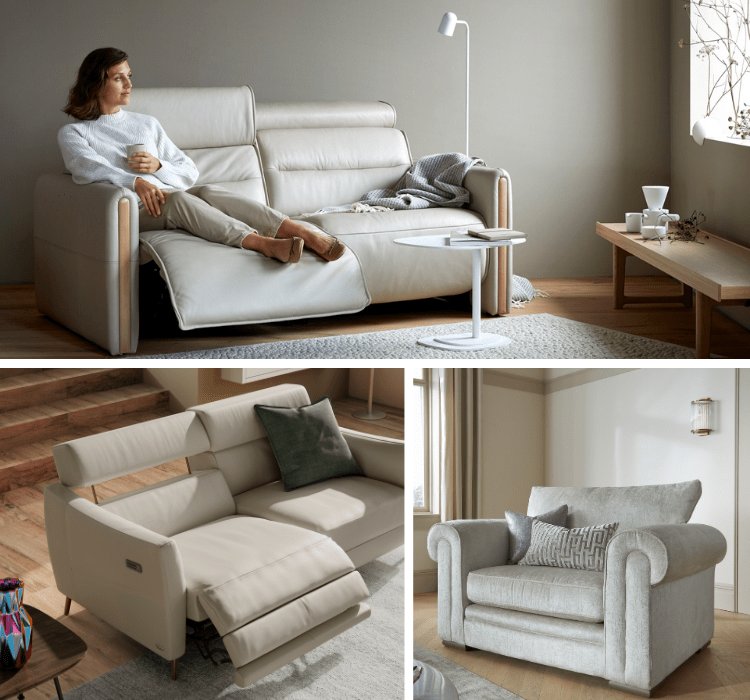Creating Comfort in your Home
![]()
Spring is here and it’s time to relax and unwind in the warm pools of sunshine (hopefully) gracing your home and garden. Creating comfort in your home means thinking about texture, colour, light, function and convenience. It means adding versatility and flexibility as well as the obvious elements of how plush or supportive your sofa is.
Here are our top 7 ways to feel comfortable in your home.
1. Control the clutter
![]()
![]()
Clutter, mess and chaos (even ‘organised chaos’) make us feel stressed, overwhelmed and perhaps a little like we’ve lost control of our space. Too much ‘stuff’ on show can feel oppressive. Balance your decorative items or books etc, on open shelves with white space, which means giving things space to breathe, visually. Clutter also means we mislay or lose things and we can waste valuable time searching. It’s a cliche, but if you have a place for everything and keep your space visually ordered you will definitely feel the benefits.
2. Balance form and function
![]()
It’s no good creating a beautiful looking home, or room, if it doesn’t also make your life easier in some way. So make sure your space works for you.
Consider - Do you have enough places to put down a drink or your phone while you’re sitting on the sofa?
Are there enough sockets and are they in the right places? Are you bedside tables big enough to keep everything you need on show?
Do you need somewhere to put your feet up while watching Netflix, (other than the glass coffee table)? What can you move, add, remove or change to make your home work best for you to make everyday life more convenient?
Think storage, work surfaces, lighting and circulation round a room. Do you have an annoying table you catch your hip or shins on? What could you do to prevent that?
3. Light it right
![]()
![]()
Lighting has the power to transform a plain or simple room into something quite special, or ruin an otherwise gorgeous room if the lighting is too harsh, or insufficient. You’ll have noticed that the latest LED bulbs offer warm or cool lighting. Whilst cool lighting is really useful in a kitchen or bathroom, you really want to have warm lighting everywhere else, to create a comfortable, relaxing ambiance. Interior designers talk about layering lighting, which means having different light types and sources for different requirements. Whatever you do, try to move beyond downlight or overhead pendants alone. Floor and table lamps, or main lights on dimmers offer a much more pleasant experience and task lighting can be critical to avoid eye strain. If you’re renovating or building a new home consider 3 pin lamp sockets which can give you that hotel experience of lamps being switched at the wall.
4. Get Comfy
![]()
Of course comfort is crucial for items we spend a lot of time on, for example sofas, armchairs, office chairs and beds. Some furniture materials are more high maintenance than others and it’s really important to balance how soft a chair, sofa or bed is, with how easy it is to get in and out of. Think about people in the family being different heights, weights, or having different needs and get expert advice when in store. Don’t be afraid to ask lots of questions and shop around. Sit in different positions on the sofa and try out the bed as you would lie on it.
5. Layer it up
![]()
![]()
Add comfort by layering soft furnishings, such as cushions, throws and rugs. You can add lower back support with a lumbar cushion, a cushion for your head or a cosy throw to snuggle up in on chilly winter nights. If your house has hard floors and some rooms feel echoey or a bit spartan, a large shaggy rug can really make a difference which you can feel, see and hear. And think also about curtains or blinds. Do you need blackout linings for a good nights’ sleep? Would an interlined door curtain help reduce draughts from your front door?
6. Go plant based
![]()
![]()
Plants and natural materials are literally life-enhancing and including green foliage or flowers in your home will not only look visually attractive, but can help reduce pollutants in the home. Biophillic design is a huge design trend and one that never really goes out of fashion. And if you’re really not green-fingered, or are away too much to be able to care for plants, consider faux ones, which can be incredibly realistic. Natural is best if possible. Think also about furnishing your home with natural and sustainable materials for example, bamboo, hemp or linen. Or why not look into recycled plastics which can be manufactured into textiles which feel incredibly soft and are very durable?
7. Consider your colour scheme
We’re all drawn to different colours and strengths of colour, but certain colours have universal impacts on our energy and state of mind. For a comfortable and relaxing bedroom, you’d be best to go for soft tonal colours of green or blue, rather than red or orange which can be too stimulating and energising. You might want to paint one or more walls in your office in a bold colour you love so that you both enjoy being in the room and get more done.
- 17th April 2023




-min.png)






